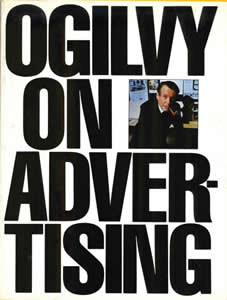 “Pretend you started work this morning in my agency, and that you have dropped by my office to ask for advice. I will start with some generalities about how to go about your work. In later chapters I will give you more specific advice on producing advertisements for magazines, newspapers, television and radio. I ask you to forgive me for oversimplifying some complicated subjects, and for the dogmatism of my style – the dogmatism of brevity. We are both in a hurry.”
“Pretend you started work this morning in my agency, and that you have dropped by my office to ask for advice. I will start with some generalities about how to go about your work. In later chapters I will give you more specific advice on producing advertisements for magazines, newspapers, television and radio. I ask you to forgive me for oversimplifying some complicated subjects, and for the dogmatism of my style – the dogmatism of brevity. We are both in a hurry.”
So begins David Ogilvy (the creative head of Ogilvy & Mather) in his classic book, describing in plain language what it takes to create great advertising and lead an organization. He also includes lots of advertisements that work – with a description of why they were effective.
In chapter 2, he provides the following key advertising points:
- It doesn’t always work. The wrong advertising can reduce the sales of products.
- Do your homework. Read everything you can about your client’s product with an eye toward what promise would most likely make someone buy their brand.
- Position your product. Make it clear who the product is for and what it does.
- Brand image, which is comprised of name, packaging, price, style of advertising, and the nature of the product.
- The big idea. Big ideas make products stand out and be remembered and are truly rare. Nowadays people hope that outrageousness will suffice for “big idea” (think Superbowl advertisement). Instead, here are 5 questions to ask:
- Did it make me gasp when I first saw it?
- Do I wish I had thought of it myself?
- Is it unique?
- Does it fit the strategy to perfection?
- Could it be used for 30 years?
- Make the product the hero. You want the advertising copy to clearly solve the audience’s problem (“save the day”).
- The positively good. You don’t have position your product as superior to your competition. If the consumer feels certain yours is good and uncertain your competitors is, they will often buy yours to be safe.
- Repeat your winners. Just because you’re tired of an advertisement, doesn’t mean your audience is. Make your choices based on data, not feelings.
- Learn from direct response. Since direct response writers focus on what works in writing copy, do what they do (unless you have a proven solution that’s better): longer commercials, broadcast late at night, and use long copy. The best advertisements sell the most.
- The cult of creativity. If it doesn’t sell, it isn’t creative. Don’t strive for originality at the expense of what works.
In chapter 7 he gives details of what works in print advertising:
- Start with a great headline. Include the brand name. Ten or fewer words. Make it contain news (something new about the product). Make it specific (more memorable). Put it in “quotes” to increase recall by 28 percent. If you advertise locally, put the name of the city in the headline. Make it obvious – don’t use double meanings to be clever.
- Photographs produce better results than illustrations (but photographs don’t always reproduce well). Make the image arouse the reader’s curiosity. Show the end result of using the product. The most common effective imagery? Cute babies, cute animals, and sex appeal. The gender of the person in the ad should be the same as the target market (people want to identify with the image). His two favorite layouts: a large photograph (3/4 of the ad) with a brief headline and up to 240 words of copy and a narrow photograph (1/4 of the ad) with a longer headline (up to 20 words), a subheading, and 600 words of copy.
If you’re looking for ideas for your own advertising or marketing, have a copy of this book at-hand to inspire you.